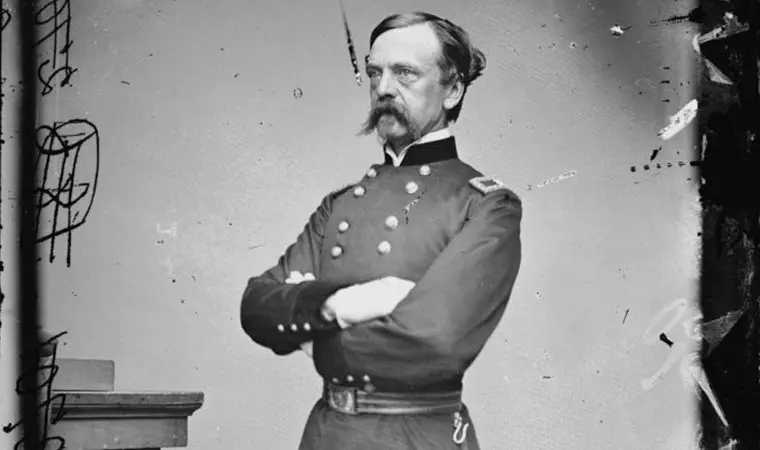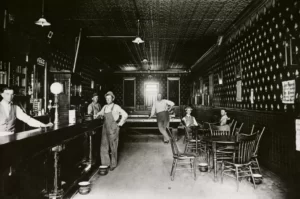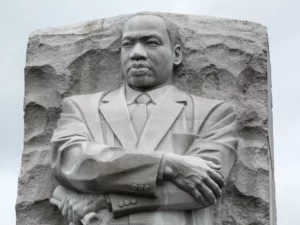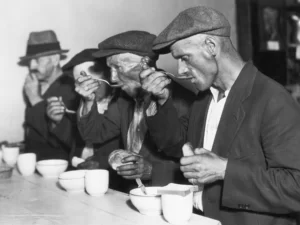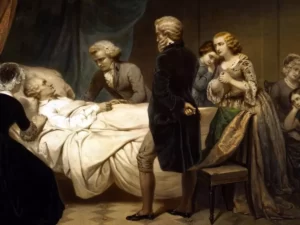Despite having little prior military experience, Daniel Sickles was appointed a Union general during the Civil War. He gave his amputated limb to the Army Medical Museum after losing it at the Battle of Gettysburg. Additionally, he killed a man in broad daylight. Let’s discuss Daniel Sickles, the Civil War’s rowdiest general
Daniel Sickles Shot Francis Scott Key’s Son
Daniel Sickles was born in 1819 to Susan Marsh and George Garrett Sickles, a politician and patent attorney in New York; Daniel would later claim that he was actually born in 1825. Following in his father’s footsteps, Sickles attended what is now known as New York University and passed the bar in 1846. But his aspirations quickly shifted to politics. Sickles was successful in getting elected to the New York State Assembly in 1847, thanks to the support of his close friends at Tammany Hall.
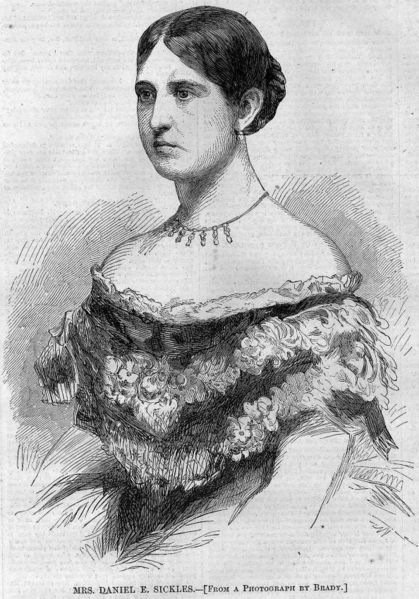
For many years, Sickles had known Teresa Bagioli. He was a good friend of her family, and while getting ready for college, he even resided with her family for a year. Of course, Teresa was still a newborn at the time. Daniel Sickles and Teresa Bagioli were married in the summer of 1852 in spite of the opposition from both of their families. He was 32. She was only 15 years old. Sickles allegedly lied about his birth year, wanting people to think he was younger than he actually was. But despite or perhaps because of her youth, Teresa was well-liked by the Washington elite.
The Sickles family would host formal dinners every Thursday. And according to many accounts, Teresa was a welcoming and warm host. She would even attend seances with Mary Todd Lincoln, the wife of President Abraham Lincoln, developing a fast friendship with the first lady. While Sickles made his child bride think their marriage was wonderful, he was actually having affairs with a number of other women, including the famed courtesan Fanny White, who he famously attended a diplomatic mission with Sickles in place of his wife.
Teresa, then 21 years old, began an affair of her own with Philip Barton Key, a US district attorney and the son of Francis Scott Key, the writer of the “Star-Spangled Banner,” after suffering years of maltreatment at the hands of her husband. After receiving a letter describing his wife’s transgressions with Key, Daniel Sickles armed himself with three different pistols and went in search of his wife’s lover. “Key, you scoundrel,” shouted Sickles. “You have dishonored my house! You must die!” Across the street from the White House and in broad daylight, Sickles fired upon the unarmed Key twice. One of the shots was deliberately aimed at his groin. A few hours later, Philip Barton Key was dead. And Sickles was arrested for murder.
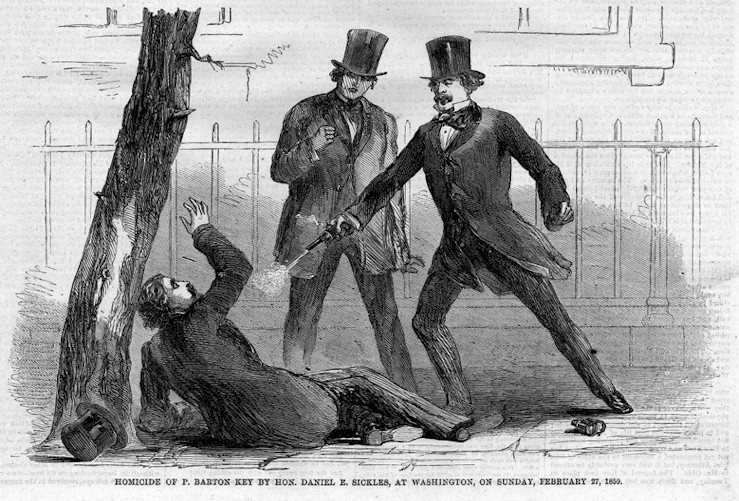
He Defended That He Was Innocent
While in jail and awaiting his trial, Daniel Sickles had so many visitors that he was granted the use of the head jailer’s apartment to welcome all of his guests. It wasn’t typical for detainees to do this, but Daniel Sickles wasn’t your typical prisoner. He served in the US Congress. Washington was on his side even though he had fully admitted to the murder.

A number of powerful politicians leaped at the opportunity to represent one of their own. Edwin M. Stanton, who subsequently went on to become President Lincoln’s secretary of war, was a member of Sickles’ legal dream team. The defense presented by Sickles’ attorneys was that of temporary insanity. A former US senator was willing to describe Sickles strange and paranormal noises just before the murder.
However, Sickles’ mental state wasn’t the only factor. The world’s oldest legal playbook was likewise followed by his legal team – blaming the victim. “It may be tragical to shed human blood”, stated one of the Sickles’ seven lawyers, “And I will always maintain that there is no tragedy about slaying the adulterer. His transgression takes away the catcher of the occurrence.”
The press was also on the side of Sickles. He was praised as a hero by Harper’s Magazine, which claimed Daniel Sickles only crime was, “saving all the ladies of Washington from this rogue named Key.” The jury began deliberating after 20 days of testimony. No one ever before in American history had invoked temporary insanity to assert innocence. Nevertheless, seven of the jurors were convinced that Sickles should go free.
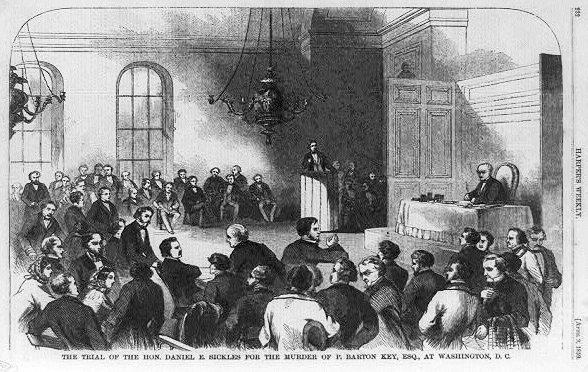
However, there were two religious jurors who felt morally conflicted about convicting a murderer. But the two recalcitrant men gave in after much debate and prayer. Daniel Sickles was greeted as a hero as he left the courthouse. Washington rejoiced. Both the general populace and the press were as well. But the love fizzled out quickly. After Sickles had the nerve to publicly forgive his wife’s adultery, they turned on him.
He Gladhanded His Way To The Top
Sickles’ defeat in his upcoming congressional contest was anticipated. Instead of fighting for his seat, he chose to go back to New York to spend more time with his wife, family, and mistresses. At the start of the Civil War, Daniel Sickles departed from Congress.
By enlisting soldiers to fight for the Union back in New York, Sickles discovered a new technique to win over his allies in Washington. Sickles had never served in the military, but he was a fantastic recruiter. Daniel Sickles was able to become a military officer with the assistance of none other than Abraham Lincoln since he had so many soldiers willing to fight for him. A sizable group of soldiers, the majority of whom had little experience, were being led by a man with no prior military expertise. What could go wrong?

The Civil War’s bloodiest engagement was the Battle of Gettysburg. Additionally, it was the Union’s decisive victory, resulting in General Lee’s submission and leading to the dissolution of the Confederacy. It was also the battle where a clueless general with no prior military training violated orders, slaughtered his soldiers, had his leg shot off, and came dangerously close to altering the course of history.
Major General George Meade, General Daniel Sickles’ superior, gave him the order to keep his Third Army Corps soldiers at Little Round Top. But Sickles was dissatisfied with his post and sought to shift his troops to a more elevated location. Sickles marched his forces a mile to the Peach Orchard, which was essentially indefensible but did have a somewhat higher terrain, in defiance of explicit orders. General Meade ordered a generals meeting to discuss Sickles’ disobedience after observing Sickles’ activity. Sickles showed up for the meeting after it had ended. And the Confederate Army launched an attack while Sickles was attempting to withdraw his corps back to their original position, utterly destroying Sickles’ men. While attempting to retreat, Sickles leg was hit by a Confederate cannonball. Later that day, the leg was removed.
Sickles insisted on being taken back to Washington after the battle, where he delivered the initial report of the decisive Union victory at Gettysburg to the White House. Then he began his lifelong quest to portray himself as a war hero and launched a scathing attack on Major General Meade’s character, even going so far as to falsely claim that Meade had a secretive withdrawal strategy. A few historians contend that Sickles’ poor leadership actually benefited the Union by weakening the Confederates’ military position. However, the majority simply believe he was a fool who nearly gave the war to the Confederacy.

Sickles was aware of a recent order from the Army surgeon general to gather and send samples of morbid anatomy to the Army Medical Museum in Washington, which had just been established. Sickles donated the leg bones from his leg to the museum in a little coffin-shaped container. According to reports, Sickles used to pay a visit to the limb on the anniversary of its amputation. Usually, he would bring a date because, well, why not? The leg is still on exhibit today.
Trips Abroad
Sickles returned to politics after the Civil War and advocated for Reconstruction on the grounds of treating African-Americans fairly and upholding the rights of workers. He also stopped property foreclosures and prohibited whiskey production.
Sickles was selected to represent the US as ambassador to Mexico and Spain in 1869. The ousted Queen Isabella II was said to have had an affair with Sickles in Madrid. Sickles then wed Carmina Creagh, one of Queen Isabella’s maids, four years after the premature death of his wife Teresa who passed from tuberculosis. The presumably content couple had two kids later on.
Central Park
Sickles is also remembered for his role in the creation of Central Park. Sickle set out to form “…a consulting committee of 24 gentlemen, prominent in our municipal social life, with whom I was in the habit of conferring upon all questions of importance.” The committee, headed by Sickles, opted for the current location of Central Park over a much smaller site in a separate area. Sickles claimed that a bigger park was necessary for the expanding metropolis. Sickles himself benefited from the decision as well. The value of the building lots he had purchased, which were close to the new location, would soar once the park opened.
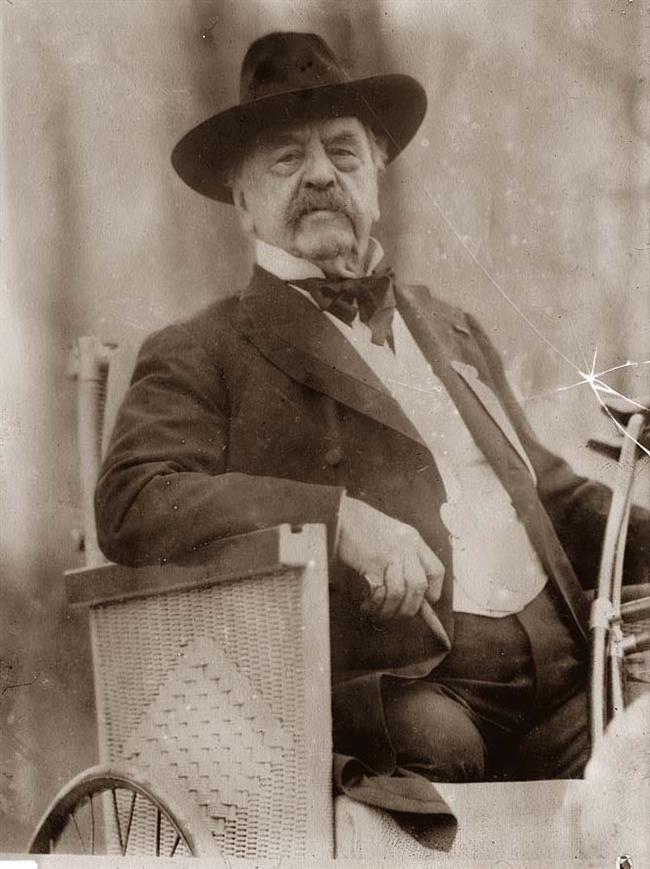
Later, after Central Park had been created, Sickles gave the Central Park Zoo exotic animals. Sickles oversaw the construction of Civil War monuments in New York as the chairman of the New York State Monuments Commission. He held the position for two decades until 1912 when officials discovered $27,000 missing from the commission’s funds. Sickles was arrested at 93 years old. But once more, Sickles was able to stay out of jail.
His friends gathered enough cash to make up for the “lost” funds. He then passed away two years later. He is interred at Arlington National Cemetery. Daniel Sickles had personally lobbied for the Medal of Honor for more than 34 years before receiving it just before he passed away.
